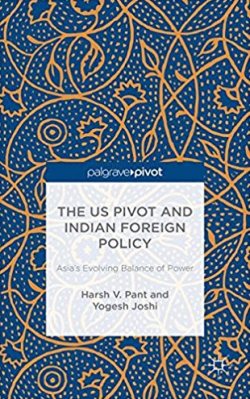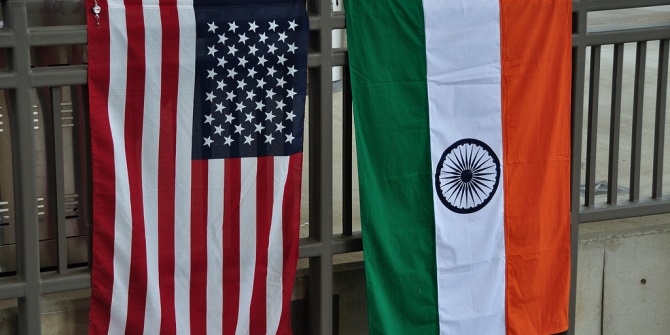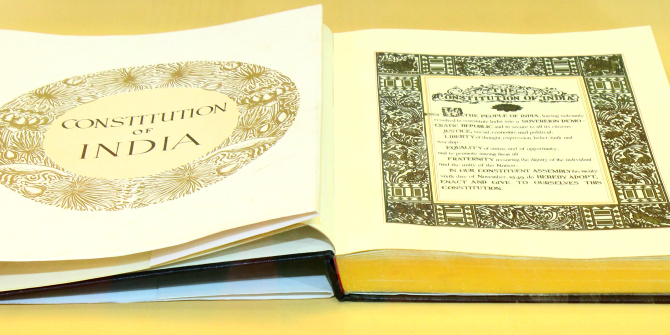In their new book The US Pivot and Indian Foreign Policy, Pant and Joshi explore India’s response to the USA’s strategic balancing approach in the Asia-Pacific region. Raj Verma finds the book a wide-ranging examination of US-China-India relations but argues it would have benefitted from a more focused approach.
The US Pivot and Indian Foreign Policy: Asia’s Evolving Balance of Power. Harsh V. Pant and Yogesh Joshi. Palgrave Macmillan. 2016.
 China has made remarkable economic progress after reforms were introduced by Deng Xiaoping in 1978. It has emerged as the second largest economy behind the US, and overtook the US to become the largest economy in the world in purchasing power parity terms in the end of 2015. Economic growth has also led to an increase in military power. After the global financial crisis in 2008, China assumed that the West and the US were in decline and followed an assertive foreign policy, especially with respect to the countries in East Asia over island disputes in the South China Sea and East China Sea and with India over the disputed border. On becoming President, Obama tried to accommodate a rising China under the G2 framework. However, China’s persistent aggressiveness led to the US ‘Pivot to Asia-Pacific’, which was later rechristened as ‘strategic balancing’. In their book, Pant and Joshi examine India’s response to the US pivot. The book has been published in the Palgrave ‘Pivot’ series which allows authors to publish manuscripts within a range of 25,000-50,000 words.
China has made remarkable economic progress after reforms were introduced by Deng Xiaoping in 1978. It has emerged as the second largest economy behind the US, and overtook the US to become the largest economy in the world in purchasing power parity terms in the end of 2015. Economic growth has also led to an increase in military power. After the global financial crisis in 2008, China assumed that the West and the US were in decline and followed an assertive foreign policy, especially with respect to the countries in East Asia over island disputes in the South China Sea and East China Sea and with India over the disputed border. On becoming President, Obama tried to accommodate a rising China under the G2 framework. However, China’s persistent aggressiveness led to the US ‘Pivot to Asia-Pacific’, which was later rechristened as ‘strategic balancing’. In their book, Pant and Joshi examine India’s response to the US pivot. The book has been published in the Palgrave ‘Pivot’ series which allows authors to publish manuscripts within a range of 25,000-50,000 words.
The book employs the concept of ‘balance of power’ from the realist school as the conceptual framework. The book discusses the political and military aspects of the ‘pivot’ but ignores the Trans Pacific Partnership (TPP), the economic arm of the pivot which can be traced to the liberal school of thought. The aim of the TPP was to increase the US economic engagement in Asia-Pacific especially with ASEAN countries, diminishing their dependence on China’s economy and hence distancing them from China’s coercive economic diplomacy or economic statecraft. For instance, China imposed a ban on imports of bananas from Philippines over the disputed islands in the South China Sea in May 2012. The authors cite examples of China’s economic statecraft such as stopping export of rare earth metals to Japan and discuss India’s increased economic engagement with Japan but do not mention US economic engagement in the region.
The main argument of the book is that although systemic factors propel India to enter into an alliance with the US to balance against a rising and assertive China, India is hedging against its neighbour rather than endorsing the pivot. This is due to Indian policy of ‘strategic autonomy’ and concerns about excessive US demands from alliance partners, domestic politics in India and the failure of the ‘pivot’ due to lack of a coherent policy, US decline and US resolve. Pant and Joshi argue that India has followed a three-pronged strategy to hedge against China. First, India is reconfiguring its relationship with the US, the existing hegemon. Second, it has tried in vain to improve its relations with China, the challenger with which it has a long running border dispute leading to a war in 1962 in which India was comprehensively defeated. Third, India is deepening and strengthening its strategic partnerships and engagement with regional powers in East Asia such as Japan, South Korea and the ASEAN countries especially Vietnam, Indonesia and Singapore.
The authors assert that there is continuity in India’s hedging with respect to China under the National Democratic Party government headed by Narendra Modi, although the means are different: Modi has pursued a more proactive and assertive hedging strategy relative to the defensive strategy pursued by United Progressive Alliance-II government headed by Manmohan Singh. They aver that India cannot internally balance China because it lacks the comprehensive national strength to do so. The best option is to balance externally with the US at the helm and also strengthen economic, military, political and institutional relationship with Japan and other countries in Asia-Pacific. Additionally, India perceives the ‘pivot’ both as an opportunity and as a concern.
The book is divided into six chapters and has a conclusion. The first chapter is the introductory chapter. It discusses concepts such as hedging, power transition and strategic flux. It briefly discusses India’s response to the US ‘pivot’ and the structure of the book. Chapter two discusses US decline in relative and absolute terms in some detail. This is followed by a discussion on the origins of the ‘pivot’ and the power transition in Asia with the countries fearful of an ascending and revisionist China challenging US hegemony in the region. This has resulted in instability and strategic flux in the region. The last section discusses the impact of the ‘pivot’ on India’s foreign policy with respect to China, the US and the region. The authors assert that Indian foreign policy is in a state of flux.

Chapters three to six discuss the three arms of India’s hedging strategy with respect to China. The third chapter focuses on India-US relations, discussing why the US perceives India as the ‘lynchpin’ of the ‘pivot’ and provides a comparative analysis of India-US relations under the Singh and Modi governments. It illustrates how the relationship has undergone a qualitative and quantitative change under the Modi government. Chapter four discusses India-China rivalry. The authors assert that the rivalry is protracted and has manifested itself in the border dispute, struggle for strategic space in South Asia, East Asia and the Indian Ocean and China-Pakistan strategic partnership aimed at balancing India and containing its rise to great power status. The chapter illustrates the difference in India-China relations under the Singh (accommodative) and Modi (assertive engagement) governments. Chapter five examines India’s relations with Japan under the Modi and Singh governments. The authors assert that although the strategic partnership has improved by leaps and bounds in economic, military and multilateral domains, there is dissonance regarding the nuclear issue. Chapter six briefly examines India’s strategic relations and security and defence ties with Vietnam, Australia, Indonesia, South Korea and Singapore. The authors argue that it is not imperative that India enter into military alliances with these countries to balance China.
The book is a pithy and easy read for those interested in India’s Look/Act East Policy and India-China-US relations under Singh and Modi governments, however it is arguably ‘old wine in a new bottle’. The wine would have a better taste and made a greater contribution the existing literature if the book had focused on India’s foreign policy under the Modi and Singh governments and explicated the reasons for the difference. Second, a more accurate title would have been ‘India’s Look/Act East Policy and US pivot to Asia’. The emphasis would have been on the congruence and incongruence between Look/Act East policy and the ‘pivot’, and India’s relations with China, the US and East Asian countries.
This article gives the views of the authors, and not the position of the South Asia @ LSE blog, nor of the London School of Economics. Please read our comments policy before posting.
About the Author
Dr Raj Verma is the Series Editor of ‘Routledge Series on India-China Studies’. He can be contacted at rajneeshverma2000@gmail.com.







